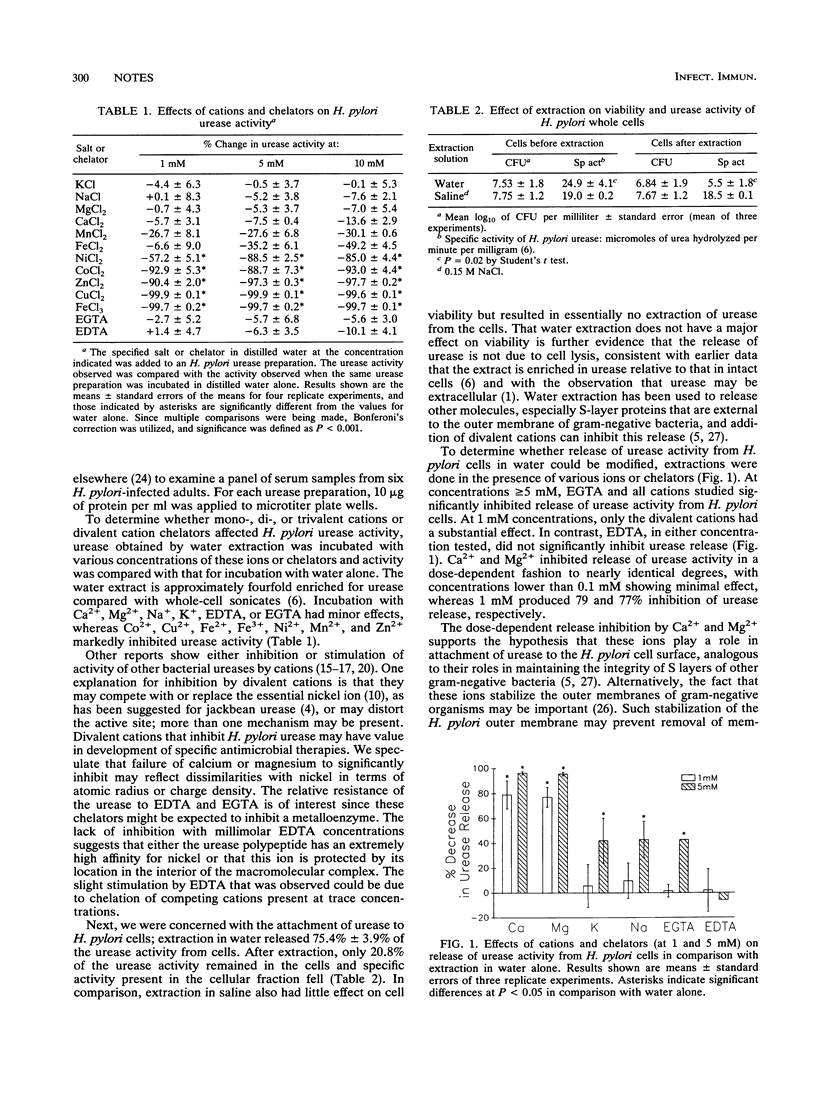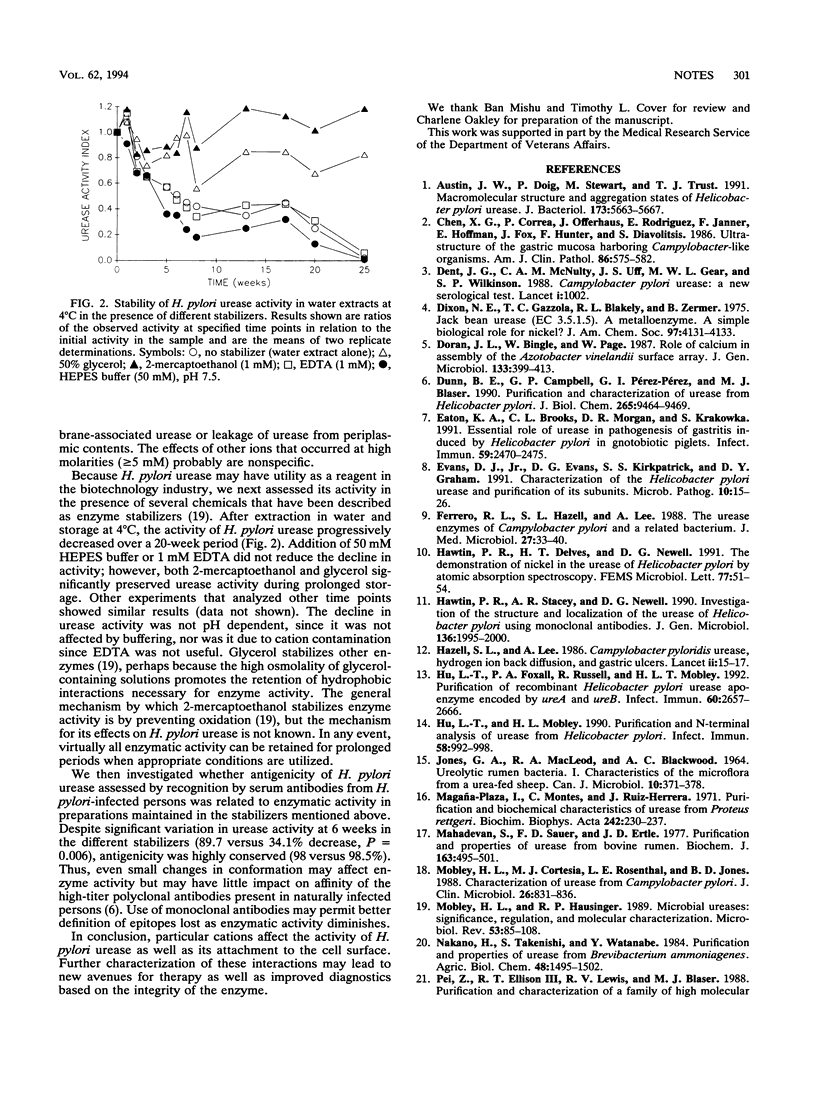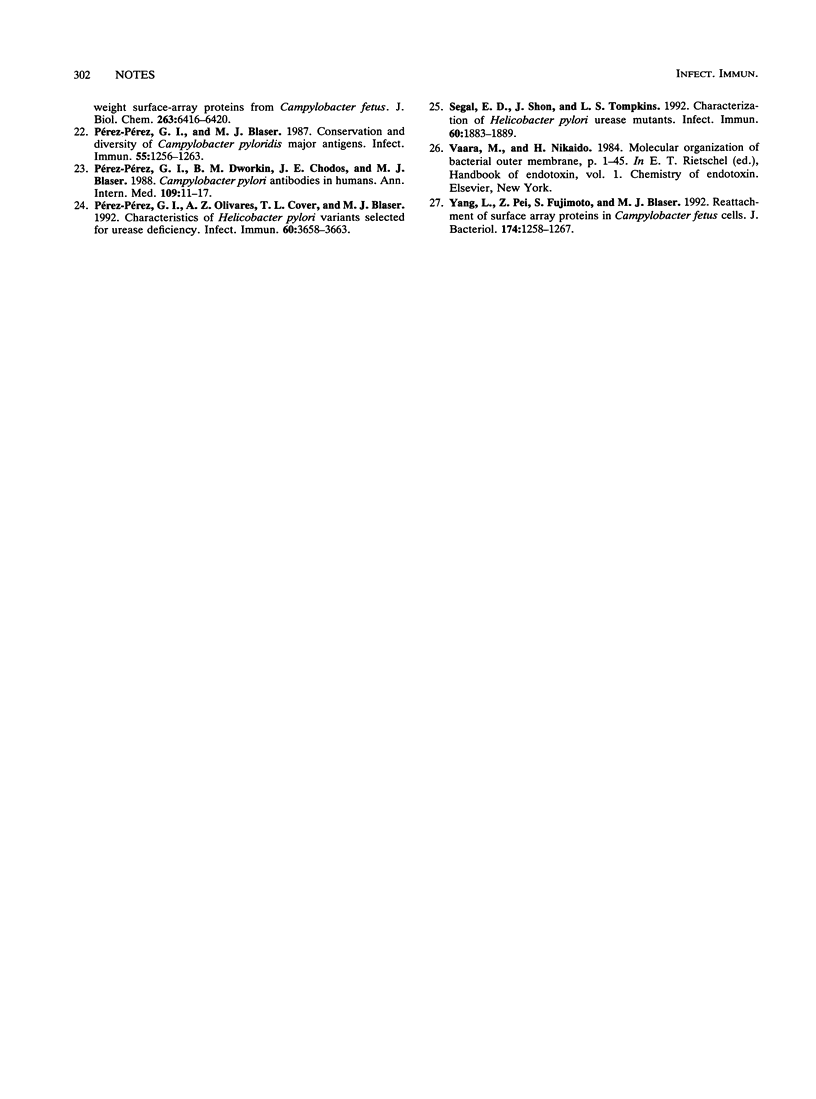Abstract
The urease of Helicobacter pylori is an important antigen and appears critical for colonization and virulence. Several studies have indicated a superficial localization for the H. pylori urease, and the purpose of this study was to determine the effects of cations on the release and stability of urease activity from H. pylori cells. Incubation of partially purified H. pylori urease in water containing 1, 5, or 10 mM Ca2+, Mg2+, K+, Na+, EDTA, or EGTA [ethylene glycol-bis(beta-aminoethyl ether)-N,N,N',N'-tetraacetic acid] had little effect on activity. In contrast, 1 mM Fe3+, Cu2+, Co2+, or Zn2+ substantially (> 80%) inhibited activity, and 10 mM Fe2+, Mn2+, and Ni2+ inhibited about 30% of the activity. Addition of Ca2+ or Mg2+ markedly decreased extraction of urease from intact H. pylori cells by water, but 1 mM Na+, K+, EGTA, or EDTA each had minimal effects on release, suggesting that divalent cations have a role in attachment of urease to H. pylori cells. The stability of enzymatic activity at 4 degrees C was enhanced by addition of glycerol or 2-mercaptoethanol; however, even after loss of activity, full antigenicity for human serum was retained.
Full text
PDF



Selected References
These references are in PubMed. This may not be the complete list of references from this article.
- Austin J. W., Doig P., Stewart M., Trust T. J. Macromolecular structure and aggregation states of Helicobacter pylori urease. J Bacteriol. 1991 Sep;173(18):5663–5667. doi: 10.1128/jb.173.18.5663-5667.1991. [DOI] [PMC free article] [PubMed] [Google Scholar]
- Chen X. G., Correa P., Offerhaus J., Rodriguez E., Janney F., Hoffmann E., Fox J., Hunter F., Diavolitsis S. Ultrastructure of the gastric mucosa harboring Campylobacter-like organisms. Am J Clin Pathol. 1986 Nov;86(5):575–582. doi: 10.1093/ajcp/86.5.575. [DOI] [PubMed] [Google Scholar]
- Dent J. C., McNulty C. A., Uff J. S., Gear M. W., Wilkinson S. P. Campylobacter pylori urease: a new serological test. Lancet. 1988 Apr 30;1(8592):1002–1002. doi: 10.1016/s0140-6736(88)91827-2. [DOI] [PubMed] [Google Scholar]
- Dixon N. E., Gazzola T. C., blakeley R. L., Zermer B. Letter: Jack bean urease (EC 3.5.1.5). A metalloenzyme. A simple biological role for nickel? J Am Chem Soc. 1975 Jul 9;97(14):4131–4133. doi: 10.1021/ja00847a045. [DOI] [PubMed] [Google Scholar]
- Dunn B. E., Campbell G. P., Perez-Perez G. I., Blaser M. J. Purification and characterization of urease from Helicobacter pylori. J Biol Chem. 1990 Jun 5;265(16):9464–9469. [PubMed] [Google Scholar]
- Eaton K. A., Brooks C. L., Morgan D. R., Krakowka S. Essential role of urease in pathogenesis of gastritis induced by Helicobacter pylori in gnotobiotic piglets. Infect Immun. 1991 Jul;59(7):2470–2475. doi: 10.1128/iai.59.7.2470-2475.1991. [DOI] [PMC free article] [PubMed] [Google Scholar]
- Evans D. J., Jr, Evans D. G., Kirkpatrick S. S., Graham D. Y. Characterization of the Helicobacter pylori urease and purification of its subunits. Microb Pathog. 1991 Jan;10(1):15–26. doi: 10.1016/0882-4010(91)90062-f. [DOI] [PubMed] [Google Scholar]
- Ferrero R. L., Hazell S. L., Lee A. The urease enzymes of Campylobacter pylori and a related bacterium. J Med Microbiol. 1988 Sep;27(1):33–40. doi: 10.1099/00222615-27-1-33. [DOI] [PubMed] [Google Scholar]
- Hawtin P. R., Delves H. T., Newell D. G. The demonstration of nickel in the urease of Helicobacter pylori by atomic absorption spectroscopy. FEMS Microbiol Lett. 1991 Jan 1;61(1):51–54. doi: 10.1016/0378-1097(91)90012-y. [DOI] [PubMed] [Google Scholar]
- Hawtin P. R., Stacey A. R., Newell D. G. Investigation of the structure and localization of the urease of Helicobacter pylori using monoclonal antibodies. J Gen Microbiol. 1990 Oct;136(10):1995–2000. doi: 10.1099/00221287-136-10-1995. [DOI] [PubMed] [Google Scholar]
- Hazell S. L., Lee A. Campylobacter pyloridis, urease, hydrogen ion back diffusion, and gastric ulcers. Lancet. 1986 Jul 5;2(8497):15–17. doi: 10.1016/s0140-6736(86)92561-4. [DOI] [PubMed] [Google Scholar]
- Hu L. T., Foxall P. A., Russell R., Mobley H. L. Purification of recombinant Helicobacter pylori urease apoenzyme encoded by ureA and ureB. Infect Immun. 1992 Jul;60(7):2657–2666. doi: 10.1128/iai.60.7.2657-2666.1992. [DOI] [PMC free article] [PubMed] [Google Scholar]
- Hu L. T., Mobley H. L. Purification and N-terminal analysis of urease from Helicobacter pylori. Infect Immun. 1990 Apr;58(4):992–998. doi: 10.1128/iai.58.4.992-998.1990. [DOI] [PMC free article] [PubMed] [Google Scholar]
- JONES G. A., MACLEOD R. A., BLACKWOOD A. C. UREOLYTIC RUMEN BACTERIA. I. CHARACTERISTICS OF THE MICROFLORA FROM A UREA-FED SHEEP. Can J Microbiol. 1964 Jun;10:371–378. doi: 10.1139/m64-050. [DOI] [PubMed] [Google Scholar]
- Magaña-Plaza I., Montes C., Ruiz-Herrera J. Purification and biochemical characteristics of urease from Proteus rettgeri. Biochim Biophys Acta. 1971 Jul 21;242(1):230–237. doi: 10.1016/0005-2744(71)90103-3. [DOI] [PubMed] [Google Scholar]
- Mahadevan S., Sauer F. D., Erfle J. D. Purification and properties of urease from bovine rumen. Biochem J. 1977 Jun 1;163(3):495–501. doi: 10.1042/bj1630495. [DOI] [PMC free article] [PubMed] [Google Scholar]
- Mobley H. L., Cortesia M. J., Rosenthal L. E., Jones B. D. Characterization of urease from Campylobacter pylori. J Clin Microbiol. 1988 May;26(5):831–836. doi: 10.1128/jcm.26.5.831-836.1988. [DOI] [PMC free article] [PubMed] [Google Scholar]
- Mobley H. L., Hausinger R. P. Microbial ureases: significance, regulation, and molecular characterization. Microbiol Rev. 1989 Mar;53(1):85–108. doi: 10.1128/mr.53.1.85-108.1989. [DOI] [PMC free article] [PubMed] [Google Scholar]
- Perez-Perez G. I., Blaser M. J. Conservation and diversity of Campylobacter pyloridis major antigens. Infect Immun. 1987 May;55(5):1256–1263. doi: 10.1128/iai.55.5.1256-1263.1987. [DOI] [PMC free article] [PubMed] [Google Scholar]
- Perez-Perez G. I., Dworkin B. M., Chodos J. E., Blaser M. J. Campylobacter pylori antibodies in humans. Ann Intern Med. 1988 Jul 1;109(1):11–17. doi: 10.7326/0003-4819-109-1-11. [DOI] [PubMed] [Google Scholar]
- Pérez-Pérez G. I., Olivares A. Z., Cover T. L., Blaser M. J. Characteristics of Helicobacter pylori variants selected for urease deficiency. Infect Immun. 1992 Sep;60(9):3658–3663. doi: 10.1128/iai.60.9.3658-3663.1992. [DOI] [PMC free article] [PubMed] [Google Scholar]
- Segal E. D., Shon J., Tompkins L. S. Characterization of Helicobacter pylori urease mutants. Infect Immun. 1992 May;60(5):1883–1889. doi: 10.1128/iai.60.5.1883-1889.1992. [DOI] [PMC free article] [PubMed] [Google Scholar]
- Yang L. Y., Pei Z. H., Fujimoto S., Blaser M. J. Reattachment of surface array proteins to Campylobacter fetus cells. J Bacteriol. 1992 Feb;174(4):1258–1267. doi: 10.1128/jb.174.4.1258-1267.1992. [DOI] [PMC free article] [PubMed] [Google Scholar]


